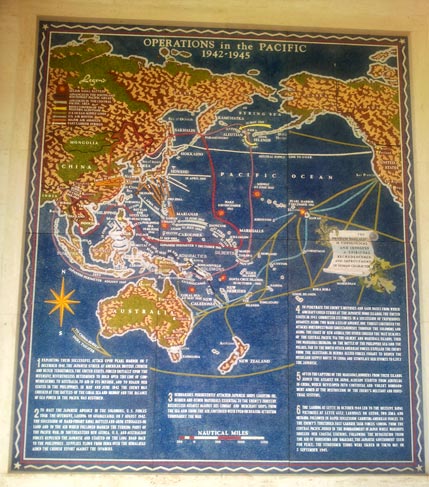Punchbowl’s Art
I had a recent weekend visit by the 17-year-old son of close friends in Australia. James is in a summer program for talented high schoolers at Stanford University in the Bay Area. Using Australian “Down Under” geographical logic, he figured Palo Alto is much closer to Hawaii than is Australia, so he hopped over for a couple of days while he was so “close by.”
His agenda included golf (he’ll be on the Pro Tour one day) and a visit to Diamond Head crater. I thought, hey, a pretty sharp kid – wants to get a feel for an actual volcanic crater. Turns out he has a NASCAR video game in which cars race through the Diamond Head tunnel and around the inside of the crater. He just wanted to check the reality quotient.

A WWII battle map of the Pacific at Punchbowl. Jerry Coffee photo.
Nevertheless, I figured one good crater deserves another, so we went from Diamond Head to Punchbowl. As we turned into the crater, the lad was truly awed by the beauty and solemnity of the sight.
After parking, we ascend ed the steps leading up between the “Courts of the Missing,” white marble slabs bearing the names of the 28,788 military personnel either missing or buried at sea in World War II and the Korean and Vietnam wars. At the top and looking out over the Puowaina (Hill of Sacrifice) is the statue of Lady Columbia, signifying all grieving mothers. The inscription at her base is taken from a letter from Abraham Lincoln to a Mrs. Bixby, who it was believed at the time had lost all five of her sons in the Civil War: “… the solemn pride that must be yours to have laid so costly a sacrifice upon the altar of freedom.”
A small but elegant chapel is located behind the statue. The Christian cross, the Jewish Star of David and the Buddhist Dharma Wheel displayed there symbolize the religious beliefs of nearly all who are interred the National Memorial Cemetery of the Pacific at Punchbowl.
Extending out on eitherside of the chapel are map galleries depicting all the major battles of the Pacific war. Each of the 10 maps is a striking work of art, which somehow never registered with me on previous visits. The original battle maps were created by an Italian process as old as the Bible called scagliola, using a technique and materials touted by the Italians “to last forever and a day.” But Honolulu’s humidity is far greater than that of Florence and Rome, and within three years the maps had peeled from their Carrara marble bases.
By 1972 the original maps were all replaced with new ones made of precast, tinted mosaics of concrete and colored glass aggregate – a process developed by Mary Morse Hamilton Jacobs of Glenelg, Md., and manufactured in “Early Studio” in Manassas, Va. The overall beauty, extraordinarily bright colors and detail far exceeded that of the original maps.
James had heard his granddad’s war stories of Aussies fighting the Japanese invaders in New Guinea, barely 100 miles from the northern-most tip of Australia. From his grandfather’s personal accounts, James was able to trace his path across New Guinea’s Southeastern peninsula from the Solomon Sea to Port Morsby on the Coral Sea, the headquarters of Australian military activity in that island nation. From this peninsula the Aussies launched a major offen-sive along the northern coast of New Guinea that didn’t stop until they joined the American forces to help recapture the Philippines from the Japanese.
The 10 existing maps – one of the overall Pacific military operation, one of the Korean peninsula, and eight dedicated to other major island offensives such as Guadalcanal and the Battle of the Coral Sea – comprise one of Oahu’s least-known art treasures. But for maximum appreciation, they must be digested slowly and with attention to detail.
Fortunately, the American Battle Monuments Commission has already approved an additional gallery featuring two new maps on the Vietnam War designed by the same woman who envisioned the existing ones. They are being constructed as I write, and will be dedicated Veteran’s Day, Nov. 11.
What I wouldn’t give for the privilege of watching the making of those new works of battle map art. Just have to wait for the unveiling.





